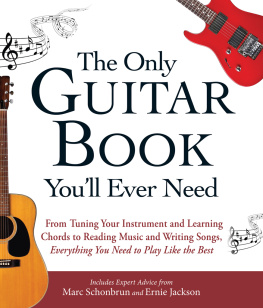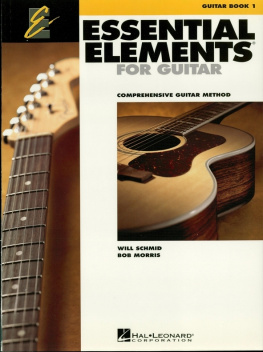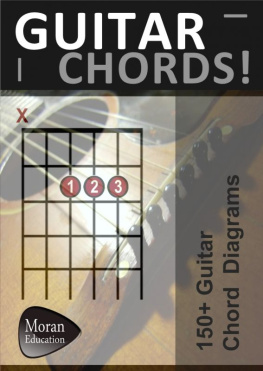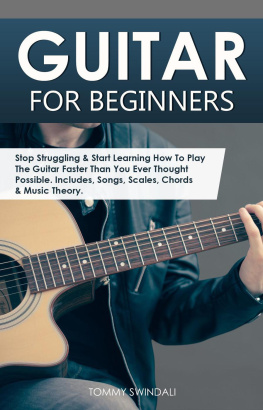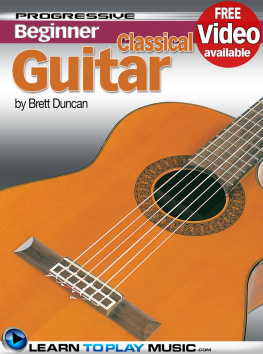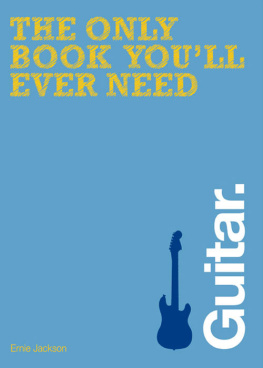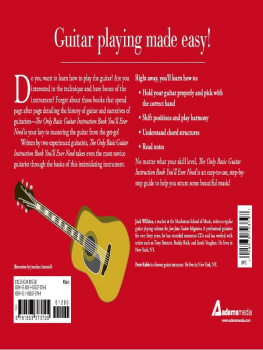The Only Guitar Book Youll Ever Need
From Tuning Your Instrument and Learning
Chords to Reading Music and Writing Songs,
Everything You Need to Play Like the Best
Includes Expert Advice from
Marc Schonbrun and Ernie Jackson

Avon, Massachusetts
INTRODUCTION
For Guitar Lovers
Welcome to The Only Guitar Book Youll Ever Need! You are embarking on quite a journey, so plug in and hold on. Guitar playing is a vast and open-ended topic. The goal here is to equip students with the material required to advance toward their full potential.
There is no single right way to play guitar. In fact, its the diversity of performers that keeps such a wide audience interested. This book will show you all the important techniques and concepts that make the guitar what it is.
This book is designed for anyone with an interest in the guitar, whether youve just picked it up or have been playing for a while. The chapters in this book are organized in a logical order, but you should feel free to skip around. Whether youve played for twenty years or twenty minutes, there is something here for you.
This book covers all aspects of guitar from the most basic techniques to more complex chords. At first, new concepts and sounds may seem foreign, even unsettling. In time, these will become familiar. Youll be able to see your own progress by revisiting old material. Melodies that are a challenge when you begin will seem easy after a few months of practice using this book as a guide.
Throughout this book, musical examples help to illustrate ideas that are discussed in the chapters. All the examples use standard notation and tablature. If you cant read music yet, dont worry. Thats covered here too.
The focus of this book is application, not theory. Each chapter consists of new material followed by extensive discussion on where to use the new ideas and concepts. Youll be able to hone your skills and find your own sound with the skills you learn from this book. Lets get started!
PART 1
The Basics
The Origin of the Guitar
There are many theories on the origin of the guitar. In fact, the ancient pictures, drawings, and paintings of many cultures suggest a guitar, though these are actually stringed instruments of varying types. For example, Babylonian excavations in Central Asia unearthed cave carvings dating back to 1900 b.c. that show musicians playing together. The carvings feature stringed instruments resembling guitars as well as techniques like strumming and plucking of the strings. Similar stringed instruments like the okongo or cora are still used in parts of Africa to this day.
EARLY GUITARS
Early Egyptian drawings show stringed instruments that resemble very complex lyres and harps. Ancient Rome was heavily influenced by Egyptian culture, and as a result there were many versions of these two instruments in early Western cultures. Around a.d. 400, for instance, the Romans brought their tanbur, also known as the chitara, to Spain.
Varying types of stringed instruments developed in the pre-Christian Babylonian, Egyptian, and Hittite cultures of the Middle East as well as in Roman Italy, Greece, and Turkey in the Near East. All these instruments had certain aspects in common. Each had some sort of sound box and a long neck. Cords or strings were stretched down the neck and over the sound box. Players used one hand to strum (perhaps with a plectrum, or pick, of some sort) and the other to stop the strings at various points along the neck; as a result, they could sound a wide variety of notes, both singly and together.
Musical Notes
The Greeks had a stringed instrument called the kithera. Though the spelling is close to the word chitara, it is not a direct ancestor of the modern-day guitar. The kithera is closer to a lyre or harp.
Medieval Europe
In the early Middle Ages, as the Moors passed through Egypt on their way to conquer North Africa and Spain, they brought the ud, a direct antecedent of the guitar, to Western Europe. The Moorish influence in Spain prepared the groundwork for the development of the guitar in Europe. By the thirteenth century, references to and pictures of guitar-like instruments begin to appear in historic documents from all over Europe.
The Four-Course Guitar
It is possible that makers of the Roman-style chitara and the Arabic ud influenced one another. By a.d. 1200, the four-string guitar had evolved into two types: the guitarra morisca (Moorish guitar), which had a rounded pear-shaped back, a wide fingerboard, and several sound holes somewhat like a lute; and the guitarra latina (Latin guitar), which resembled a small version of the modern guitar, with one sound hole and a narrower neck. On either of these instruments, each pair of strings was called a course.
Musical Notes
The guitar has many forebears and cousinsthe lute, the Middle Eastern ud, the Indian sitar, the banjo, the koto of Japan, the bouzouki of Greece, the vihuela, the yue-chin, chirar, balalaika, rehab, kayakeum, santir, ombi, vambi, nanga, samisen and on and on.
In 1487, a musical theorist named Johannes Tinctoris described an instrument he called the guiterra or the ghiterna, whose sides were tortoise-shaped. Guitar historians today believe that what Tinctoris actually saw was a round-back lute. In Italy, these instruments were known as the viola da mano and chitarra.
The Six-Course Guitar
While the guiterra was small and had four courses, the Italian chitarra was larger, with six courses. Both had thongs or cords tied at various places along the neck to make frets or squared-off divisions of the neck. These two instruments became the favorites of wandering troubadours or minstrels. These virtual one-man bands had to master a variety of instruments, including pipes, whistles, and flutes, plus perform songs, tell stories, and provide any other form of entertainment that would earn them money and keep them from facing the displeasure of aggravated patrons.
Musical Notes
Minstrels did not use the guitars to accompany their stories but to play small instrumental interludes between verses or tales or to sing folksongs.
Heres how an eleventh-century Swiss poet named Amarcius described a minstrels performance: When the citharist appears, after arranging for his fee, and proceeds to remove his instrument from its cover of oxhide, the people assemble from far and near, fix their eyes upon him and listen with soft murmurs as he strikes the strings with his fingers stretched far apart, strings which he himself has fashioned from sheep gut, and which he plays now tenderly, now with harsh booming sounds.
The Lute
The lute held court as the major stringed instrument for a long while, but it had a number of drawbacks. First of all, there was no standard lute, so some were large and some smaller. Some had eight strings, while others had twelve or even more. They were difficult to balance and play, and forget about keeping one in tune!
Musical Notes
A keen musician himself (and rumored to be the composer of Greensleeves), King Henry VIII had more than twenty guitars among his collection of musical instruments in Hampton Court Palace.

